 Midget Italian Torpedo boats: MT, MTS, MTL
Midget Italian Torpedo boats: MT, MTS, MTL
The MAS inheritance
During the WW1 and WW2 superstars of the “naval dust” deployed by the Regia Marina were the MAS (For Motoscafo armato silurante) or “torpedo armed motorboat”. They gave all satisfaction during the great war in the confines of the Adriatic, but less so during WW2 where the far larger theater of operation prevented their weak range to be use as effectively (they only sank the C-class cruiser Capetown and failed to assault Malta harbor). But still, on coastal areas around Italy, they could reach any target at 176 nautical miles at 27 knots (325 km).
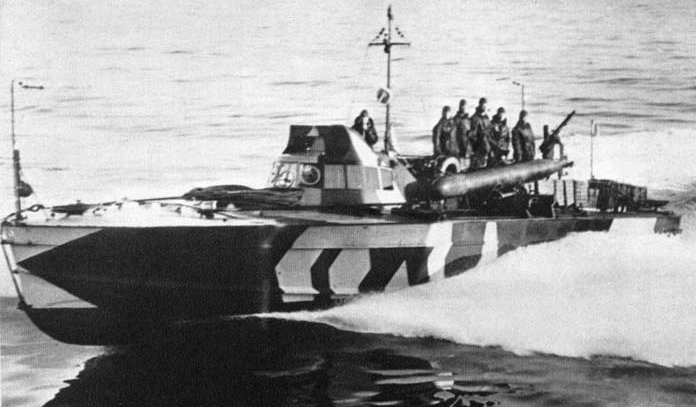
Relative deception and replacement
The pioneer was SVAN, followed by Baglietto for wartime production and around 80 were manufactured from the first interwar prototypes to the last 1943 MAS 555 series. Despite their construction marrying wood with aviation engines, 25 tons and crew of 8-13 which did not took a toll on the Regia Marina’s resources, there were considerations about a more easier and foremost cheaper approach already in 1941.
The MAS carried 450 mm (aviation) torpedoes and deep-charges plus AA, and were suitable also for ASW vessels, although found undersized to be really efficient. On the other hand for purely coastal defensive duties, they were seen as too versatile and oversized. By 1943 the last serie of 30 boats was cancelled anyway, as the admiralty realized the larger German S-Boats (they used ex-Yugoslavian boats of German origin and appreciated the design) and MS-boats at 60 tons were both better suited for patrols, still with MTB capabilities, as well as the ASW specialists VAS boats.
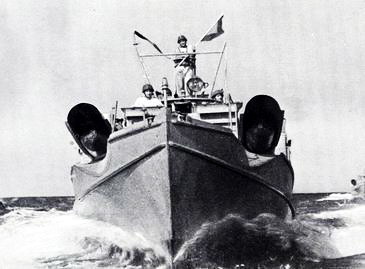
MS Boat MS-22
Italian “spec ops” boats
As it was already underlined on the Italian submarines article, the X-MAS squadron (Decima Mas) operated a range of small crafts and boats in various operations, some failures, some tremendous successes. The attack of Malta on 27.6.1941 was a disaster, but several concepts were developed and the team, led by the Italan “black Prince” Junio Valerio Borghese, was never short of ideas.

MTM diagram (Wikimedia commons)
One of these was a micro-submarine for carrying two divers and an explosive under the hull of an anchored ship, the “Maiale” SLC, operated either from a submarine (Scirè, at Alexandria), or an underwater vault inside a tanker (Olterra, in Gibraltar). But for what we are concerned, collaboration with Baglietto gave birth to a “suicide boat”, in reality an explosive fast boat which crashed onto an enemy hull, releasing an explosive to a preset depth (MAT) and carried by a Savoia 55 seaplane (the trial was a success, the boats destroyed the old cruiser Quarto).
Later in 1938 an improved version called the MTM (Modificati) was built by Baglietto, 28 in two series completed in early 1941. Six were launched by the destroyers Crispi and Sella near the entrance of Suda Bay and they sank the cruiser York, later finished off by Stukas. A narrower beam version was also built to fit inside submarine transport tubes, called MTR (Ridotto) but apparently never passed the drawing board stage. All these boats will be studied in a dedicated post, but the boat concept fuelled the idea of a micro-MTB.
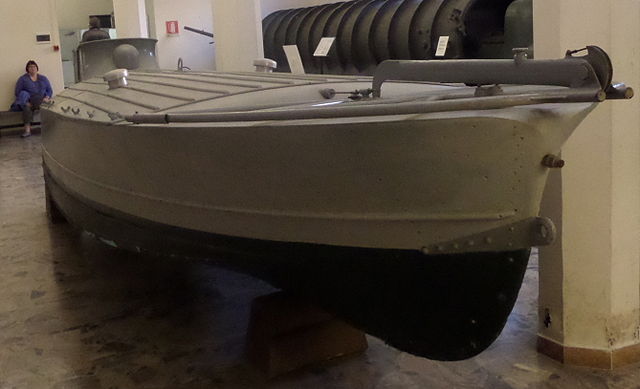
Prow of the MTM at the Naval Museum of Venice
Development of the Motoscafi Di Turismo
Micro-MTB and motherships
The concept of micro-torpedo boat has many precedents. The oldest was the idea of a mothership to carry these, pioneered in the 1890s already with ships such as La Foudre and British HMS Vulcan. Thy would have protected the fleet was an array of light boats usually reserved to coastal areas and in some ways, preceded the idea of the aircraft carrier, another mothership. Both proved the concept was only sound on paper: The boats were too small to be effective if the sea was not still as a lake.
Famous Italian engineer Benedetto brin designed for his 1880 Ironclad Caio Duilio a compartment in her stern to house a small torpedo boat. This was the 26.5 long tons (26.9 t) Clio. But the concept was never adopted by any other navy.
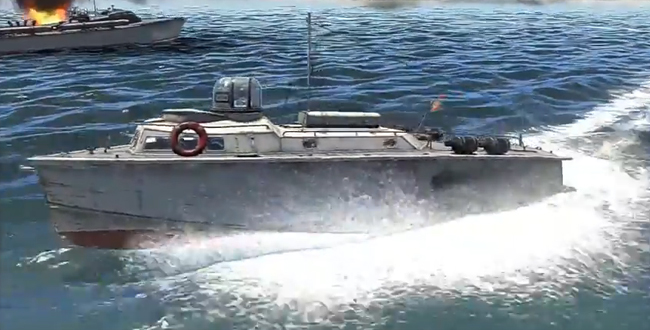
In WW2, the Germans renewed the concept with their Leichte Schellboote (LS) concept. These LS1 series were designed to be carried also by motherships, German commerce raiders Komet, Michel and Kormoran. Schiff 5 was also to carry one (and a Fa 330 Bachselze rotary wing kite), before being damaged and once repaired, serve as a cadet ship. LS1 boats (20 built in 1941-42) were a potential good inspiration for the Italians. However the Germans planned for them two ultra-light 450 mm torpedoes which development was never completed and instead the two first of these 11 tons, 12.57 m x 3.27 x 0.83 m boats built at Dornier Werft Friedrichshafen carried three TMB magnetic mines. However only the first three became operational and up to the LS12, the other completed in 1941-44 were relegated to escort missions in the Mediterranean and up to LS38 they were never completed or cancelled.
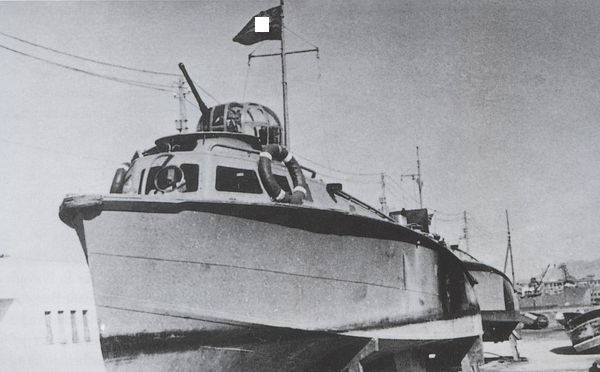
MTS (4 built, 1940)
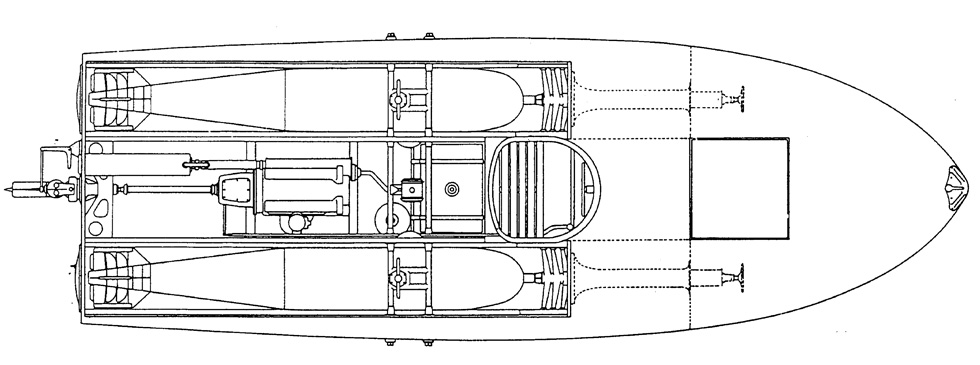
Top view of the MTS. Credits: credits http://www.anb-online.it
The Motoscafo Turismo Silurante (MTS) or “Motoscafi di Turismo Silurante” (Torpedo-carrying touring boat), was the Italian way to produce a large number of coastal MTBs at a fraction of the cost of a MAS boat. The basis would be the standard adriatic “motorbarca di turismo”, typical fast boat of coastal areas used by the Italian Gentry. It was to be wooden-hulled and propelled by a standard automotive engine, the same simple Alfa-Romeo 6-cyl. 2300 6 c, 90 hp used on the MTM/MTR, which was barely enough to propel the 1.7 ton boat to 28 knots.
This first model was conventionally referred to as the “Omega Project“. Final design was sanctioned at the beginning of 1940 by C.A.B.I. from Cattaneo, Milan in collaboration with Baglietto which focused on the hull alone. C.A.B.I. archives adting back from 16.7.1940 shows the longitudinal section (picure below) and also two transverse sections and transom.
To gain time, it was based on the MTM (explosive boat) by Baglietto in 1939, but englarged to carry both 2 men and 2 torpedoes, launched from the rear, tail first. The added weight of the torpedoes meant the initial MTM speed could not be met. The hull had a typical V-section. The torpedoes were of the standard aviation type, 450 mm with reduced lenght of 3.20 m, and massive in comparison of the hull, taking 4/5 of its length. They were launched as in WW1 CMBs, by compressed air. When immerged, the boat would veer of course to let the torpedo take its course and accelerate towards the target.
The four initial boats were tried in 1940. It was found their radius was 90 nm and the speed was poor for most of the time if the sea was not still, making these boats easy targets. Reports wree generally defavourable to their use. The type was never used in operations and Baglietto returned on the drawing board.

Schematics of the MTS, top view – credits http://www.anb-online.it
MTS class specifications |
|
| Dimensions | 7.15 x 2.10 x 0.5 m (23ft 6 in x 6 ft 1in x 1ft 8in) |
| Displacement | 1.7 tons |
| Crew | 2 |
| Propulsion | 1 shaft Alfa Romeo petrol 90 hp |
| Speed | 28 |
| Range | 90 nm |
| Armament | 2 x 450 mm tordpedoes |
MTL (14, 1942)
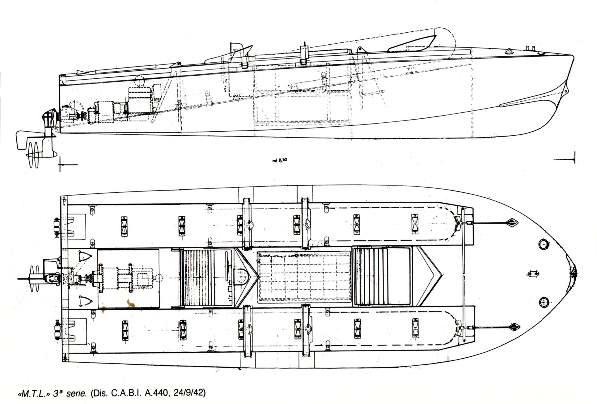
MTL 3rd serie – Cattaneo.
Called Motoscafo Trasporto (o Turismo) Lento for “Transport (Tourism) speedboat, Slow. It had a hull similar to those of the 1st series, but with a tailor-made propulsion for “spec ops”.
This rather large boats were designed to carry two SLC systems instead of torpedoes and their crews to attack Malta. They were 7 tons, 9.5 m long, but not very fast as their primary role was to approach silently by night. For this, they were provided wo engines: A cruise petrol engine for gaining the area, 22 hp, providing a 60 nautical miles range (they would be towed to site by ships), this was a twin-cylinder which was setup and manufactured to level down the vibrations, therefore the noise, coupled with an exhaust silencer.
It was linked to an electric motor rated for 8 hp, powered by accumulator batteries, and providing an additional 40 nautical miles, so about 20 to return. Of course they were planned for night attacks.
The MTL constituted also a further improvement over the first two, characterized by a single superstructure for the two pilot’s hoods and spherical smoke discharger with chloridine at the extreme stern for covert operations.
14 of these boats were built, which found their main use in the transport of divers, saboteurs and spies to operate beyond enemy lines after the armistice. They operated until 1945.
MTL class specifications |
|
| Dimensions | 9.5 x 3? x 0.8? m () |
| Displacement | 7 tons |
| Crew | 2 |
| Propulsion | 1 shaft custom petrol 22 hp, electric motor 8 hp |
| Speed | 5/4 knots (gas/electric) |
| Range | 60/40 nm |
| Armament | 2 x SLC |
MTSM (100 ordrered, 1941)

Author’s rendition of the type.
For “Motoscafi di Turismo, Silurante, Modificati”. Built in serie by Baglietto, they were drawn from the previous MTS, torpedo-armed motor boats and a cheaper, reduced version of the famous MAS during WW2.
Indeed the standard MAS of 1941 was 28 tons, powered by two Isotta-Fraschini engines for a total of 2300 hp and capable of 43 knots, while the latter MTS were given a 90 hp Alfa-Romeo engine and were 1.7 tons. The only four MTS built were deemed too small and underpowered to be effective. Baglietto changed the concept in 1940, made the hull longer and larger, and doubled the power.
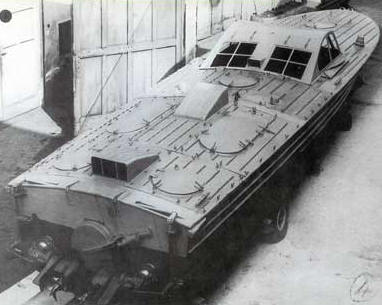
The final design was 3 tons, 190 hp, capable of 32 knots, armed with a single aviation torpedo launched by the stern, just like WW1 era MAS, and two side deep-charges. Over 100 were built in 1941-43 and they had been also used for special operations with divers. One of these, MTSM 228 torpedoed the British escort destroyer HMS Eridge on 29 August 1942.
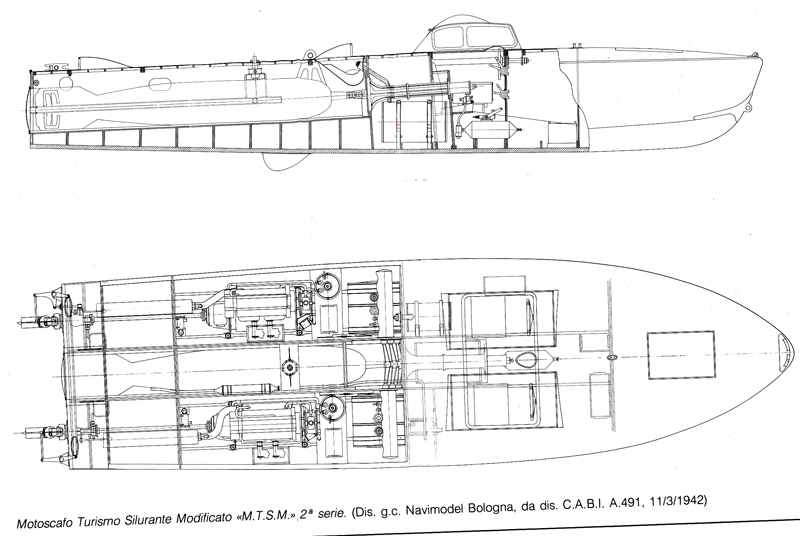
Original blueprints rendition of the MTSM – Baglietto, credits http://www.anb-online.it
These boats were given a reinforced keel and a sharper stem. They were propelled by two 95 Hp Alfa Romeo AR 6c outboard motors. 34 knots were reached fully loaded and radio equipment was installed. In addition to the single 450 mm torpedo two 50 kg depth charges were also carried in drop-collars, not to add some ASW patrol capabilities, but to be carried by the drivers to be dropped alongside ships’s hulls. First trials started in the fall of 1941. Both the admiralty and technical staff were impressed, as the MTSM surpassed specifications and expectations for top speed as well as agility and seaworthiness.
MTSM class specifications |
|
| Dimensions | 8.4 x 2.2 x 0.6 m (27ft 8in x 7ft 3in x 2ft) |
| Displacement | 3 tons |
| Crew | 2 |
| Propulsion | 2 shaft petrol Alfa Romeo 6c 190 hp |
| Speed | 32 knots |
| Range | 200 nm |
| Armament | 1x 450 mm torpedo, 2 DCs |
The Motoscafo Turismo Silurante Modificato Allargato (“Enlarged Modified Tourism Torpedo Boat”, or “extended”) was the last version of the M.T. boats, with a hull lenghtened from 8.20 m (8.40 oa) to 8.77 m (8.80 oa), and width from 2.20 to 2.32 meters to improve its nautical qualities. They could launch a single 450/320 torpedo, whereras the space could also be used to transport divers.
Just like the MTSM, a chloridine fog generator was placed at the stern, and in addition some small smoke bombs and two 70 kg ASW deep charges instead of 50 kgs were carried. They were also designed to house a larger tank, allowing a 250 nautical miles range instead of 200. They also received on the deck a single Breda machine gun for self-defence.
Initially, 100 were ordered, but this was in 1943, and ultimately only a few, if any were delivered by the time of the Italian armistice. Most were still in construction when that happened.
Blueprints of the type are now at S.I.A.I. Marchetti archives.
MTSMA class specifications |
|
| Dimensions | 8.8 x 2.32 x 0.7 m (28ft 6in x 7ft 7in x 2ft 4in) |
| Displacement | 3 tons |
| Crew | 2 |
| Propulsion | 2 shaft Alfa Romeo 6c 190 hp |
| Speed | 29 knots |
| Range | 250 nm |
| Armament | 1x 450 mm torpedo, 1 Breda MG, 2 DCs |
MS Tipo X (project, 1943)
This was a C.A.B.I. Project dated from 20.7.1943. A torpedo motorboat (Motoscafo silurante) that constituted the last evolution of the MTS. boats, reaching the level of a MAS in size and capabilities. It was 15 meters long, equipped with two FIAT A.30 engines rated for a total of 900 HP. Top speed was about 40 knots. The MS Tipo X carried with 450/320 torpedoes still launched by the same usual transom-first system of ejection from the transom powered by compressed air. None was built. Image
The MTS in action
Extract from ” German and Italian sneak craft” showing Alfa Romeo AR2500 powered motor torpedo boat MTSM and motor explosive boat MTM captured and tested in 1945 by US defence Dept.
The first action involving these boats started in 1941. In the summer of 1940 Baglietto released the first four prototypes, MTS 1-4 and they were prepared for trials and exercizes. However they were not tested before April 1941. In this operation, they tried to attack Greek naval forces at Porto Edda in Albania, on 5 April 1941. The attack was a disaster as the boats lack of seaworthiness proved their udoing. This led to a complete redesign, and the certitude that deriving a reduced MAS-type boat from the MTR series was an error.
Combat debut of the new promising MTSM started against the Allied supply line between El Alamein and Alexandria. Operated under the command of the famous Decima MAS, was constituted the botorboat column “Giobbe”. This comprised tractor MAS boats and the MTSM themselves, which lacked range. They were towed along the coast by night. Howver Allied air superiority prevented any daily use and eventually they found their first use in a night operation.
On 29 August 1942, British destroyers were shelling El Daba in Egypt. MTSM-228 (Sub-Lieutenant Pietro Carminatti and sailor Cesare Sani) attacked at 150 m, torpedoed and disabled HMS Eridge. The explisive power of the 450 mm torpedo was indeed not enough to sink any destroyer. However the ERidge was badly hit and to crippled to sail anywhere; After damage was mastered, she was towed to Alexandria by HMS Aldenham. There, she was declared a constructive total loss and used as a base ship until 1945.
MTSM-228 would be bombed by a British aircraft and abandoned by her crew soon after. At dawn, it was found still adrift there was an Italian attempt to tow her to the coast, but she was mistaken and sank by a passing by German Stuka that strafed her.

HMS Eridge (Wikimedia commons)
Meanwhile this exploit drew German interest. They made a request for another motorized column to be deployed in the black sea, operating in Crimea. It was called “Moccagatta”, to be deployed in May of 1942 in support of Operation Barbarossa. The Italian unit operated in fact until March 1943, comprising five MTMs and five MTSMs.
On the night of 6-7 June 1942, the claimed 4,000 ton Soviet freighter. However the single MTSM that crippled the ship, was later sunk by error, again, by a German aircraft. On 6 July, another MTSM captured a craft carrying 13 Soviet soldiers off Foros, which were made all prisoners.
Paradoxically, the peak of the MTSMs use happened after September 1943, when Italy signed an armistice. Ten units joined the “Free Italians”, Co-Belligerent Navy, whereas those operating with Decima MAS went on working with the Italian Social Republic, operating from northern Italy, in the Adriatic sea. In many occasions, these boats operatd also with mixed axis crews.
Read More:
www.anb-online.it/category/navi-da-guerra/mas-motosiluranti-e-mezzi-dassalto/ (IT)
www.anaim.it/decima/mezzi-assalto/ (IT)
www.regiamarina.net/detail_image_with_list.asp?nid=137&lid=2&cid=8 (IT)
www.marina.difesa.it/cosa-facciamo/per-la-cultura/musei/museotecnav/Pagine/PrincipaliMezzidAssalto.aspx (IT)
www.altomareblu.com/malta-2-lino-mancini/ (IT)
www.veniceboats.com/it-progetti-piani-barche-barche-a-motore.htm (IT)
www.icsm.it/regiamarina/carmezaseng.htm
en.wikipedia.org/wiki/MTSM_motor_torpedo_boat
www.historynet.com/naval-weaponry-italys-mas-torpedo-boats.htm
journals.openedition.org/cdlm/5535 (FR)
www.bagliettonavy.com/en/heritage/
www.icsm.it/regiamarina/carmezaseng.htm
comandosupremo.com/motoscafo-da-turismo/
en.wikipedia.org/wiki/MT_explosive_motorboat
it.wikipedia.org/wiki/CRDA_(motosilurante)
www.navypedia.org/ships/italy/it_cf.htm
s-boot.net/sboats-kriegsmarine-types.html
www.german-navy.de/kriegsmarine/ships/fastattack/ls/ships.html

 Latest Facebook Entry -
Latest Facebook Entry -  X(Tweeter) Naval Encyclopedia's deck archive
X(Tweeter) Naval Encyclopedia's deck archive Instagram (@navalencyc)
Instagram (@navalencyc)





 French Navy
French Navy Royal Navy
Royal Navy Russian Navy
Russian Navy Armada Espanola
Armada Espanola Austrian Navy
Austrian Navy K.u.K. Kriegsmarine
K.u.K. Kriegsmarine Dansk Marine
Dansk Marine Nautiko Hellenon
Nautiko Hellenon Koninklije Marine 1870
Koninklije Marine 1870 Marinha do Brasil
Marinha do Brasil Osmanlı Donanması
Osmanlı Donanması Marina Do Peru
Marina Do Peru Marinha do Portugal
Marinha do Portugal Regia Marina 1870
Regia Marina 1870 Nihhon Kaigun 1870
Nihhon Kaigun 1870 Preußische Marine 1870
Preußische Marine 1870 Russkiy Flot 1870
Russkiy Flot 1870 Svenska marinen
Svenska marinen Søværnet
Søværnet Union Navy
Union Navy Confederate Navy
Confederate Navy Armada de Argentina
Armada de Argentina Imperial Chinese Navy
Imperial Chinese Navy Marinha do Portugal
Marinha do Portugal Mexico
Mexico Kaiserliche Marine
Kaiserliche Marine 1898 US Navy
1898 US Navy Sovietskiy Flot
Sovietskiy Flot Royal Canadian Navy
Royal Canadian Navy Royal Australian Navy
Royal Australian Navy RNZN Fleet
RNZN Fleet Chinese Navy 1937
Chinese Navy 1937 Kriegsmarine
Kriegsmarine Chilean Navy
Chilean Navy Danish Navy
Danish Navy Finnish Navy
Finnish Navy Hellenic Navy
Hellenic Navy Polish Navy
Polish Navy Romanian Navy
Romanian Navy Turkish Navy
Turkish Navy Royal Yugoslav Navy
Royal Yugoslav Navy Royal Thai Navy
Royal Thai Navy Minor Navies
Minor Navies Albania
Albania Austria
Austria Belgium
Belgium Columbia
Columbia Costa Rica
Costa Rica Cuba
Cuba Czechoslovakia
Czechoslovakia Dominican Republic
Dominican Republic Haiti
Haiti Hungary
Hungary Honduras
Honduras Estonia
Estonia Iceland
Iceland Eire
Eire Equador
Equador Iran
Iran Iraq
Iraq Latvia
Latvia Liberia
Liberia Lithuania
Lithuania Mandchukuo
Mandchukuo Morocco
Morocco Nicaragua
Nicaragua Persia
Persia San Salvador
San Salvador Sarawak
Sarawak Uruguay
Uruguay Venezuela
Venezuela Zanzibar
Zanzibar Warsaw Pact Navies
Warsaw Pact Navies Bulgaria
Bulgaria Hungary
Hungary

 Bundesmarine
Bundesmarine Dutch Navy
Dutch Navy Hellenic Navy
Hellenic Navy Marina Militare
Marina Militare Yugoslav Navy
Yugoslav Navy Chinese Navy
Chinese Navy Indian Navy
Indian Navy Indonesian Navy
Indonesian Navy JMSDF
JMSDF North Korean Navy
North Korean Navy Pakistani Navy
Pakistani Navy Philippines Navy
Philippines Navy ROKN
ROKN Rep. of Singapore Navy
Rep. of Singapore Navy Taiwanese Navy
Taiwanese Navy IDF Navy
IDF Navy Saudi Navy
Saudi Navy Royal New Zealand Navy
Royal New Zealand Navy Egyptian Navy
Egyptian Navy South African Navy
South African Navy






























 Ukrainian Navy
Ukrainian Navy dbodesign
dbodesign